Electro-Acoustic Guitar Guide
Acoustic Guitar – with under saddle pickup
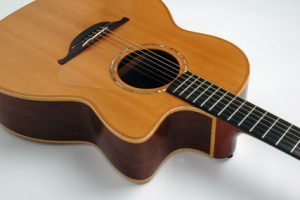 This is the author’s guitar, a Lowden F32C. It’s is a normal acoustic guitar but I have been able to use it at gigs, amplified, because it is fitted with an under saddle piezo pickup.
This is the author’s guitar, a Lowden F32C. It’s is a normal acoustic guitar but I have been able to use it at gigs, amplified, because it is fitted with an under saddle piezo pickup.
An acoustic-electric guitar is just that, a normal acoustic guitar with an added method of amplification using a pickup of some form or another.
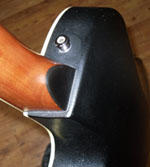 Some acoustic guitars will have a bowl back design, not using wood but a composite material. Ovation call their material Lyrachord
Some acoustic guitars will have a bowl back design, not using wood but a composite material. Ovation call their material Lyrachord
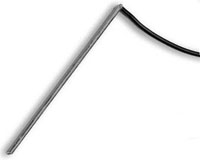 Piezo electric pickups have been around since the 1970s and Ovation, with their bowl shaped backs, were were one of the first guitars to have them fitted. The pickup comprises a strip of material that reacts to vibrations and produces an electric current as it does so. This method of amplifying the guitar is quite advantages when an acoustic guitar is required in many performance sitiations. Alternatively using a microphone, unless in a studio environment, can prove tricky. Unlike a microphone, the piezo pickup will not course feedback. (Though the resonance of the guitar body may still cause the problem with feedback)
Piezo electric pickups have been around since the 1970s and Ovation, with their bowl shaped backs, were were one of the first guitars to have them fitted. The pickup comprises a strip of material that reacts to vibrations and produces an electric current as it does so. This method of amplifying the guitar is quite advantages when an acoustic guitar is required in many performance sitiations. Alternatively using a microphone, unless in a studio environment, can prove tricky. Unlike a microphone, the piezo pickup will not course feedback. (Though the resonance of the guitar body may still cause the problem with feedback)
 Some electric guitars are fitted with piezo pickups beneath their bridge to give them an extended, versatile option of sounds. Pictured right is such a guitar – a ‘Deluxe Nashville Power Tele by Fender.
Some electric guitars are fitted with piezo pickups beneath their bridge to give them an extended, versatile option of sounds. Pictured right is such a guitar – a ‘Deluxe Nashville Power Tele by Fender.
There is no evident visible difference to that of a regular electric guitar.
One disadvantage of the piezo pickup is that, when fitted to an acoustic guitar, the sound you are hearing is not actually of the guitar’s natural resonance that pushes air through the sound hole. Instead it is a faithful correlation to the way the strings are vibrating. Careful tonal control will be required in the method of amplification.
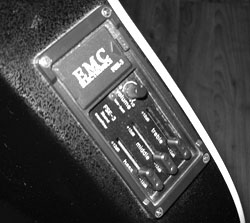 Electro-acoustic guitars will often be fitted with a built in pre-amp. This renders the signal from the output of the guitar so that it can be plugged into an external amplifier and it will most probably also have tonal filtering controls that enable frequencies such as treble, middle and bass to be set. These usually require careful consideration and to be altered in conjunction with how the master amplifier or PA system is set.
Electro-acoustic guitars will often be fitted with a built in pre-amp. This renders the signal from the output of the guitar so that it can be plugged into an external amplifier and it will most probably also have tonal filtering controls that enable frequencies such as treble, middle and bass to be set. These usually require careful consideration and to be altered in conjunction with how the master amplifier or PA system is set.
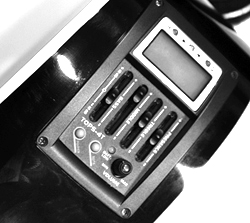 The pre-amp fitted here, to the left, also includes a guitar tuner. They may also be fitted with a conrol to reduce the feedback the guitar body may cause in situations when the guitar is amplified.
The pre-amp fitted here, to the left, also includes a guitar tuner. They may also be fitted with a conrol to reduce the feedback the guitar body may cause in situations when the guitar is amplified.
A single jack socket is all that is required from the guitar body though some are fitted with an XLR socket. The XLP facility enables the guitar to be plugged into the same input as would the microphone on an amplifier or PA system. The difference is that the ‘impedance’ of the guitar’s output is altered.
On the socket panel above there is also a facility to plug the guitar directly into a computer for recording.
An alternative to an under saddle pickup is a sound hole pickup.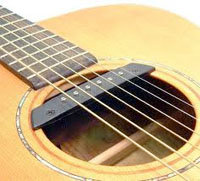
Tips:
The impedance is a measure of resistance to current and most microphones are low impedance, using 3 pin XLR connectors and sockets. It is generally observed that being able to feed your acoustic guitar into the low impedance XLR socket of an amplifier generally improves the tonal quality. When amplifying an acoustic guitar it is difficult to obtain a good and natural sounding tone so this can be a good step in the process.
If your guitar has a jack socket output then it is probably of high impedance and to change this you can connect it to your amplifier via a ‘DI’ box which will adjust the impedance to low for you.
If your guitar does not offer on board tone controls, you can still adjust the tone suitably using the amplifier’s tone controls, or those of the mixing desk and PA system.

![Acoutic guitar socket]](https://www.guitarprimer.com/wp-content/uploads/2017/06/Acoustice-Connector-socket.jpg)